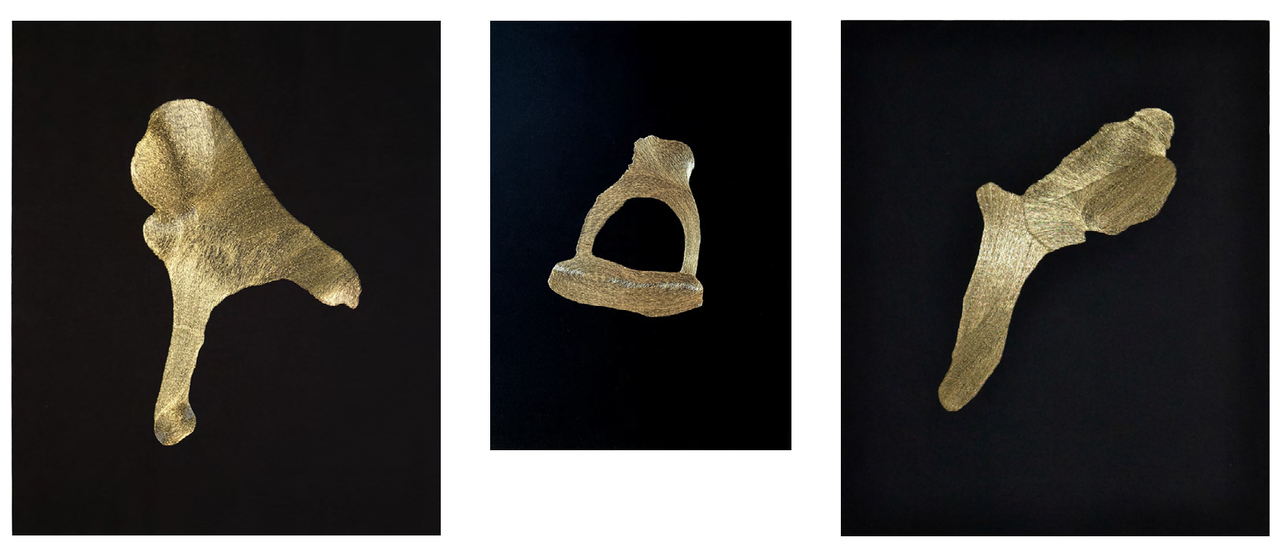Bones @_tkanka_
Justyna Kosińska’s exhibition combines the medium of artistic textile with images of human and animal bones – two areas that at first sight have little in common. Dizajn BWA Wrocław showcases embroidery works devoted to animals sacrificed for food, but also to the process of extinction of entire species vanishing from Earth’s ecosystems.

Twenty-six works by Justyna Kosińska may be viewed at Dizajn BWA Wrocław from 7 July, including embroidery in various sizes and shapes as well as objects such as a shoehorn made of a roe’s leg for the purposes of the souvenir industry or an animal bone. The Bones @_tkanka_ exhibition is a clash of the cultural and religious dimensions of human and animal remains. In this way, it refers to the Judeo-Christian tradition, mythological motifs and symbolic meanings given to some bones. Kosińska’s works expose the hierarchy of dying adopted by Western culture, which ignores the death of animals. Breeding animals – contrary to pets – are treated like objects, and their death goes unnoticed.
[The artist] places a chicken leg on the altar – a piece of bone that has become commonplace and is thrown in the garbage as mixed waste. It harks back to the veneration of relics – holy remains of the body with miraculous properties – comments the exhibition’s curator, Adriana Prodeus.
The tension which may be sensed at the exhibition results from the clash of sacrum and profanum evoked by the artist by means of colours. In her artistic practice, Justyna Kosińska relies on the symbolic use of colours – gold is a symbol of divinity, but also wealth and greed (the legend of King Midas), red refers to palatial, royal interiors, but also to blood and death. Black means death and the absolute.

Justyna Kosińska’s embroideries tell the story of the hardest matter in animal and human bodies. The skeleton devoid of the layers of tissue and skin is a carrier of memory. Bones @_tkanka_ is an exhibition which does not want to moralize. It is more of a process of the artist’s internal conversation with herself and her refusal to accept the unrestrained exploitation of animals. As she says herself, she is sensitive to changes in the environment and extinction of species, and her helplessness in the face of these facts is traumatic for her. She copes with it thanks to embroidery, which resembles meditation.
The artist considers herself a continuator of the centuries-old practice of embroidery, a technique traditionally associated with women. She makes an attempt to elevate it beyond divisions and to grant it the status of a legitimate and autonomous field of art.
***
Justyna Kosińska / @_tkanka_: was born in Warsaw. She graduated from Warsaw’s Academy of Fine Arts, Faculty of Graphic Arts. Her works have been presented at exhibitions including the POLIN Museum of the History of Polish Jews, Hos Gallery and Pracownia Wschodnia. Co-founder of the Temperówka studio of graphic art, award-winning designer of record covers, posters and books. In her works, she equates the bodies of people, animals and plants. She is fascinated by the precision of using a sharp tool and the moment when hand embroidery takes an equivocal form. The process itself is important for her. Kosińska reduces her visual language, at the same time reinforcing it. She places a same-coloured pattern embroidered with a silver or gold metallized thread on smooth, monochromatic backgrounds. She is sensitive to changes in the environment, objects to the unrestrained exploitation of animals and records the extinction of species. She considers herself a continuator of the centuries-old practice of embroidery but uses it in a painterly manner as a contemporary artist.
Adriana Prodeus: a programmer of retrospectives at the Anthology Film Archives in New York, Kinomural and New Horizons in Wrocław. She curated Olga Lewicka’s Chmuralność at Gdańsk City Gallery, Wiesław Rosocha’s Wciąż masz chamie złoty róg, Let’s Change Everything, with Katarzyna Roj at Kordegarda, Wild Fields. Avant-garde Wrocław, with a curatorial team. She has co-operated with the SURVIVAL Art Review and exhibitions at Zachęta: Antonisz. Technique Is for Me a Kind of Art and Puppets: Theatre, Film, Politics. Author of the book Themersons. Biographical Essay (2009), co-author (with Kuba Mikurda) of The Thirteenth Month of the Quay Brothers (2011). Deputy Director of U-jazdowski in Warsaw in 2015-2016, Artistic Director of the Animator Festival in Poznań since 2023. She is an editor of the KINO monthly, writes for Vogue (Demontaż atrakcji) and teaches at the Institute of Art of the Polish Academy of Sciences.
- Artist: Justyna Kosińska
- Curator: Adriana Prodeus
- Gallery programme: Katarzyna Roj
- Visual identification: Nina Gregier
- Production: Gabriela Pezda, Monika Muszyńska
- Production co-ordinator: Monika Muszyńska
- Promotion: Agata Kalinowska
- Co-operation with the audience: Daria Chraścina, Beata Marszałek, Zofia Straczycka, Magdalena Weber
- Assembly: Michał Perucki
- Organizer: BWA Wrocław Galleries of Contemporary Art